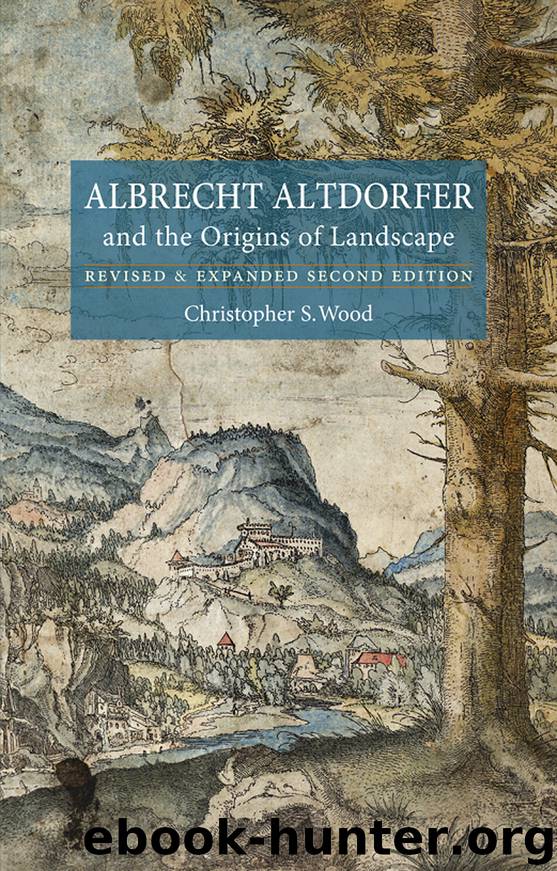Albrecht Altdorfer and the Origins of Landscape by Christopher S. Wood

Author:Christopher S. Wood
Language: eng
Format: epub
Publisher: Reaktion Books
153 Albrecht Dürer, Wire-drawing Mill, c. 1494, watercolour and gouache on paper, 29 × 42.6. Kupferstichkabinett, Berlin.
154 Northern Italian master, Cliff, late 1490s, watercolour, 20.2 × 27.3. Uffizi, Florence.
Style in Altdorfer’s pen-and-ink landscapes
Wolf Huber in his earliest dated drawing, the Bridge at the City Wall of 1505, adopted a point of view and a medium proper to the topographical report (illus. 157).51 The technique of dusting or rubbing the paper with a dry powder, usually red chalk or cinnabar, although not mentioned in Cennini’s handbook, was used in Florence from the beginning of the fifteenth century. Red tint was a quicker and cheaper substitute for opaque coloured ground. Germans used it for pen drawings of some degree of finish which were expected to last some time, such as workshop models and sketchbook pages.52 We have already looked at several drawings in this technique: two copies after Dürer prints, the Quarry after the St Jerome, from the so-called Wolgemut sketchbook in Erlangen,53 and the Mountain Landscape after the Visitation (illus. 82, 86, and two landscape drawings usually associated with Erhard Altdorfer (illus. 79, 80). Huber recorded every element of the bridge’s structure and every feature of the terrain behind it. He maintained a stationary standpoint, apparently on a small island in the middle of the river, and dutifully and awkwardly registered the odd foreshortened bulb of earth looming between himself and the gatehouse at the end of the island. But in Huber’s drawing, just as in so many early life-studies, and in Dürer’s watercolours, an initial openness to physical data transforms itself in the process of execution into a will to closure and finish. The Bridge at the City Wall is bracketed at the upper-left and -right by a tree and a tower, at the lower-left and -right by repoussoirs of earth. The bridge itself is outlined twice to distinguish it from the background. When he was finished, Huber did what Dürer almost never did: he dated his landscape.54 The date was apparently not added later, for its line resembles too closely other lines in the drawing. It actually belongs to the drawing, to the composition, as so many of Huber’s dates and monograms will in the landscapes to come.55 This is one of Huber’s earliest drawings (see pp. 239–40). The date marks neither a moment in the history of the depicted city, nor a moment shared between artist and patron (for example, a date on a presentation or contract drawing), nor a precise moment of observation (for example, the date recorded by Leonardo on his Arno landscape), but rather a moment in the career of the draughtsman. The young draughtsman who dates a drawing evinces a certain confidence that he will, indeed, have a career.
Download
This site does not store any files on its server. We only index and link to content provided by other sites. Please contact the content providers to delete copyright contents if any and email us, we'll remove relevant links or contents immediately.
The Husband's Secret by Liane Moriarty(2436)
Learn Drawing Quickly by Sharon Finmark(2417)
Drawing and Painting Birds by Tim Wootton(2338)
The Unlikely Pilgrimage of Harold Fry by Rachel Joyce(2137)
Classical Drawing Atelier by Juliette Aristides(1996)
One Drawing A Day by Veronica Lawlor(1720)
The Art of Creative Watercolor by Danielle Donaldson(1712)
Oil Painting For Dummies by Anita Marie Giddings & Sherry Stone Clifton(1658)
Hieronymus Bosch by Virginia Pitts Rembert(1577)
Elizabeth Is Missing by Emma Healey(1564)
Anywhere, Anytime Art: Crayon by Monika Forsberg(1521)
Special Subjects: Basic Color Theory by Patti Mollica(1514)
Post-Impressionism by Nathalia Brodskaya(1511)
Woman's Mysteries by Esther Harding(1460)
Memory's Wake by Fenech Selina(1399)
Fundamentals of Drawing by Barrington Barber(1260)
Landscape Painting in Pastel by Elizabeth Mowry(1210)
Acrylic Fusion by Dan Tranberg(1209)
Drawing by William Powell(1196)
